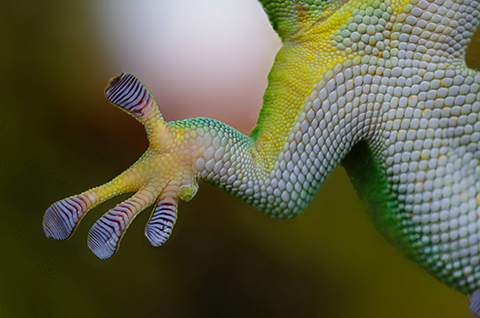
Marleen Kamperman mimics nature’s wonders
Gecko glue and magnetic dirt repellent
Have you ever seen a gecko crawling up a wall? When it reaches the top, it will continue just as easily on the ceiling. Geckos defy gravity by controlling the reversible adhesive properties on the bottom of their feet. The secret to their Spiderman-like ability is the millions of tiny hairs on the bottom of their toes that interact with the surface.
These tiny lizards were the inspiration behind professor of polymer science Marleen Kamperman’s design for synthetic materials that resemble the hairs on their feet. She wanted to make an industrial glue that is extremely strong but at the same time, easy to peel off. She was a postdoc in Germany at the time, and nature became her muse. ’I have always been interested in biological systems and I like to make new materials’, she says. ‘The research group in Germany was working on gecko glue, so that was a great fit for me.’
Geckos are not the only animals with great solutions for difficult problems. Over the past few years, Kamperman has been focusing on another creature that likes to glue itself to stuff: the mussel.
Mussel
Mussels are able to survive in harsh marine conditions because they use glue that sticks underwater, allowing the animal to attach itself to rocks or ship’s hulls. ‘It’s one of the animals that inspired me to develop technologies that would make it possible to use glue in wet conditions’, she explains. Another is the sandcastle worm – a tiny worm with tentacles with bristles on them that lives in the ocean.
Different types of companies, ranging from the shipping industry to hospitals, would love the technology to use glue underwater. Unfortunately, it has proven to be almost impossible. Water acts as a boundary that prevents the glue from adhering to a surface. In addition, some glues react quickly with water, which can harden the glue before it sticks to anything.
We only take the essence to make the polymers functional
Kamperman and her team investigated which molecules are responsible for the special water-resisting stickiness in mussel glue. The glue is made up of long protein chains that contain one amino acid in particular: 3,4-dihydroxyphenyl-L-alanine. This amino acid appears to be responsible for the stickiness.
Kamperman set out to make a synthetic equivalent of these chains, called polymers. The molecules in the synthetic chain are much simpler than the proteins that nature designed for the mussels, though. ‘We only take the essence to make the polymers functional’, she explains. ‘I take looking for inspiration in nature quite literally.’
Applications
The applications of water-resistant glue are huge. Doctors might be able to close up internal injuries with glue instead of using stitches. ‘But gluing underwater turned out to be a larger problem in general’, Kamperman says. Once the business world heard about her efforts, emails started coming in.
One company that contacted her was AquaBattery, which generates sustainable ‘blue’ energy on the Afsluitdijk, using the salt water in the Wadden Sea on one side and the fresh water of the IJsselmeer on the other. ‘Membranes in water transport ions from salt to fresh water, which generates electricity. These membranes need to be glued together, but they swell when they get wet. Therefore, it’s better to glue them after they have taken their final form.’
Companies that cultivate algae for biodiesel are interested, too. Currently, the algae are tied to a rope by hand, which is very time-consuming. Kamperman: ‘It would be much faster to glue it to the ropes. But with normal glue, 95 percent of the plants are lost in the sea.’
Degradation
Kamperman also takes inspiration from nature’s exceptional ability to degrade and recycle biomass and she really wants to incorporate it into her research. ‘We have to think about what happens to materials when they don’t serve a purpose anymore after, let’s say, twenty years’, she says. ‘We should always choose building blocks that we know how to degrade.’
We should choose building blocks that we know how to degrade
That’s why she’s part of a project to create a recyclable coating that keeps surfaces clean by repelling dirt, which could be used on the outside of buildings or the hull of a ship. However, it’s difficult to make a universal coating that repels dirt just as well as it does, say, insects. ‘That’s why we think it is better to design a coating where you can easily remove the dirty layer and then add a fresh layer on top’, says Kamperman.
Magnetic coating
To that end, her research group, together with a group at the University of Twente, is currently designing a coating that resembles two magnets sticking together. A negatively charged bottom layer will be permanently stuck to the surface with a positively charged layer on top. By changing external conditions like acidity, the charge of the top layer can be changed and the two layers will start repelling like opposing magnets.
Ideally, the polymers in the dirty layer would be biodegradable. ‘Just as in nature, it would be best to use polymers that can be fully broken down into the original building blocks and reused in new batches of polymers’, Kamperman says.
The research is still in its early stages, and Kamperman realises it will take years before anyone could manufacture a commercial product. But she is patient and optimistic. ‘We are now working on developing the first layer and so far it seems like we will succeed in making it functional.’

